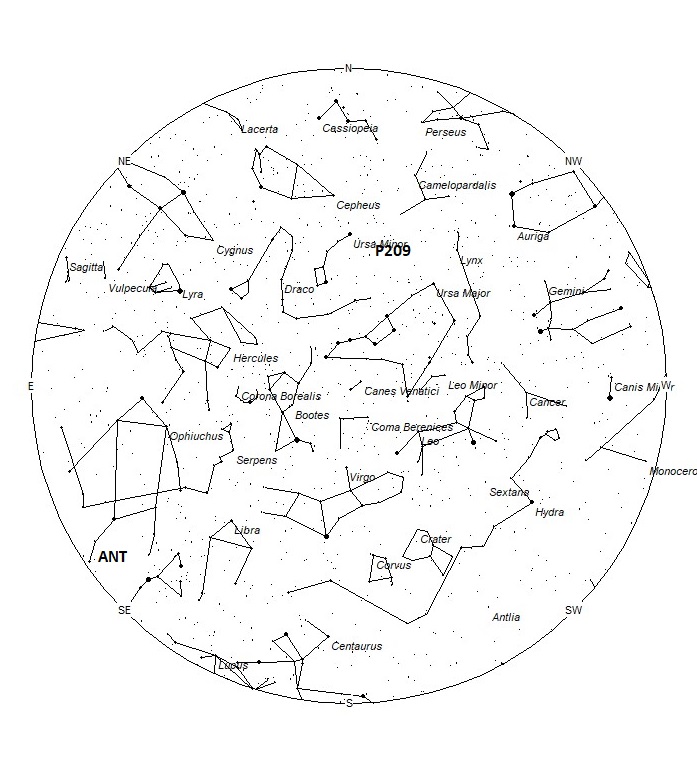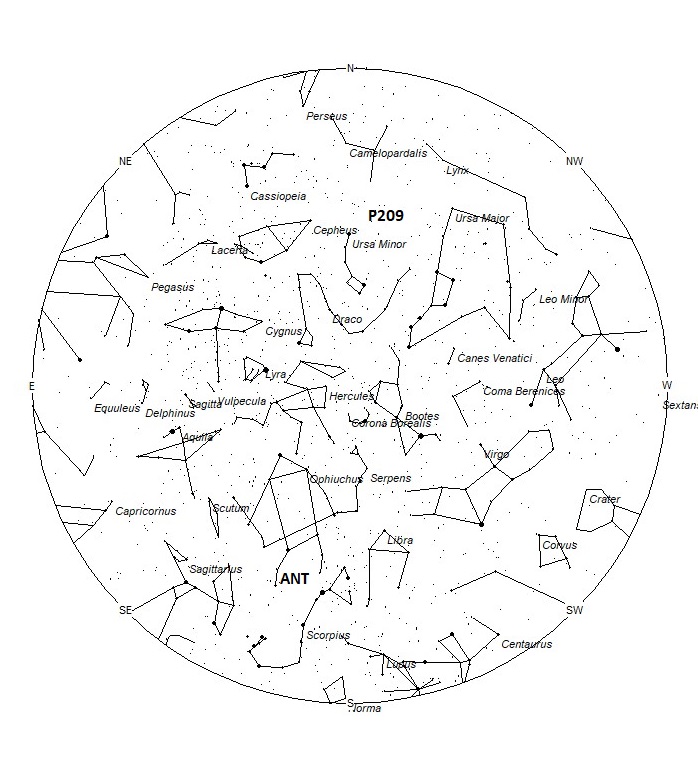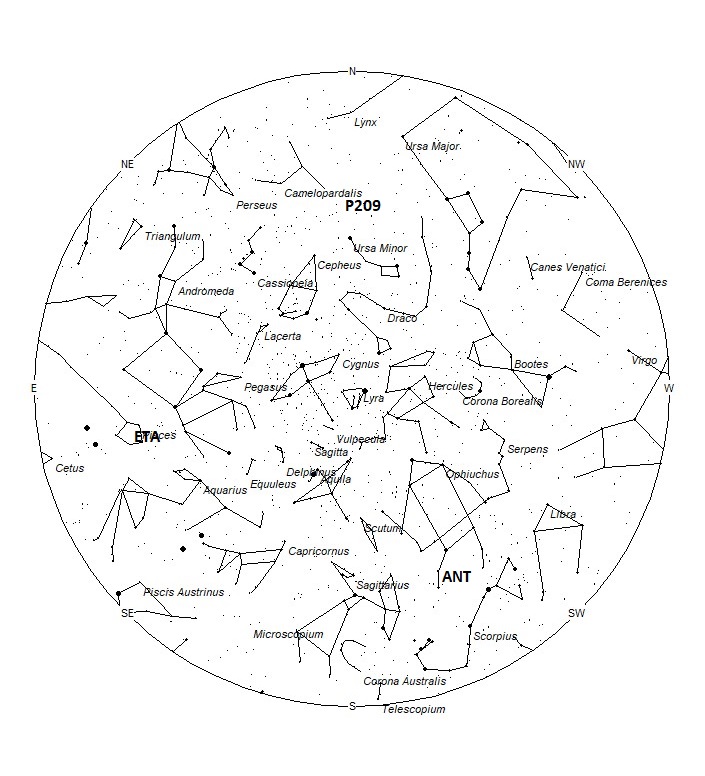 Trevor Quinn captured this horizontal fireball on March 26, 2022, at 21:08 IST from Roundwood, Co. Wicklow, Ireland. This fireball was reported by 132 witnesses from Great Britain and Ireland. For more information on this event visit: https://fireball.amsmeteors.org/members/imo_view/event/2022/2051 ©Trevor Quinn
Trevor Quinn captured this horizontal fireball on March 26, 2022, at 21:08 IST from Roundwood, Co. Wicklow, Ireland. This fireball was reported by 132 witnesses from Great Britain and Ireland. For more information on this event visit: https://fireball.amsmeteors.org/members/imo_view/event/2022/2051 ©Trevor QuinnDuring this period, the moon reaches its last quarter phase on Sunday May 22nd. At that time the moon is located 90 degrees west of the sun and rises near 0200 local daylight saving time (LDST). As the week progresses, the moon sets approximately 45 minutes later each night, allowing meteor observers to view under better conditions during the more active morning hours. For evening observers, the estimated total hourly rates should be near 3 as seen from mid-northern latitudes (45N) and 4 as seen from tropical southern locations (25S) For morning observers, the estimated total hourly rates should be near 5 as seen from mid-northern latitudes (45N) and 10 as seen from tropical southern locations (25S). Rates are reduced during the morning hours due to moonlight. The actual rates will also depend on factors such as personal light and motion perception, local weather conditions, alertness, and experience in watching meteor activity. Note that the hourly rates listed below are estimates as viewed from dark sky sites away from urban light sources. Observers viewing from urban areas will see less activity as only the brighter meteors will be visible from such locations.
The radiant (the area of the sky where meteors appear to shoot from) positions and rates listed below are exact for Saturday night/Sunday morning May 21/22. These positions do not change greatly day to day so the listed coordinates may be used during this entire period. Most star atlases (available at science stores and planetariums) will provide maps with grid lines of the celestial coordinates so that you may find out exactly where these positions are located in the sky. I have also included charts of the sky that display the radiant positions for evening, midnight, and morning. The center of each chart is the sky directly overhead at the appropriate hour. These charts are oriented for facing south but can be used for any direction by rotating the charts to the desired direction. A planisphere or computer planetarium program is also useful in showing the sky at any time of night on any date of the year. Activity from each radiant is best seen when it is positioned highest in the sky, either due north or south along the meridian, depending on your latitude. It must be remembered that meteor activity is rarely seen at the radiant position. Rather they shoot outwards from the radiant, so it is best to center your field of view so that the radiant lies at the edge and not the center. Viewing there will allow you to easily trace the path of each meteor back to the radiant (if it is a shower member) or in another direction if it is sporadic. Meteor activity is not seen from radiants that are located far below the horizon. The positions below are listed in a west to east manner in order of right ascension (celestial longitude). The positions listed first are located further west therefore are accessible earlier in the night while those listed further down the list rise later in the night.
These sources of meteoric activity are expected to be active this week.
.
On the night of May 25th near 08:00 Universal Time, the Earth is expected to encounter debris from comet 209P/LINEAR that were created by the passages of this comet through the inner solar system in 1903 and 1909. The particle density from these old trails is expected to be low, therefore activity is also expected to be low. A more favorable encounter occurred in 2014 when zenith hourly rates approached 15. The position of this radiant is expected to be 07:56 (119) +77, which is in the constellation of Camelopardalis, about half-way between Polaris and omicron Ursae Majoris (see charts). This area of the sky is best placed as soon as it becomes dark. The encounter will not occur until later in the night (4am EDT and 1am PDT) so the radiant will be lower in the sky than at dusk. North America and the northern Pacific area are best situated for this possible encounter. Due to the northerly position of this radiant, meteors from this source are not visible from the Southern Hemisphere. With an entry velocity of 16 km/sec., the average meteor from this source would be of very slow velocity. The moon will be a minor factor in the morning sky as it is a waning crescent, located in the opposite side of the sky from the radiant of these possible meteors.*
*Rendtel J., 2021, 2022 Meteor Shower Calendar, International Meteor Organization, page 6
The large Anthelion (ANT) is currently centered at 16:56 (254) -23. This position lies in southern Ophiuchus, 7 degrees northeast of the 1st magnitude orange star known as Antares (alpha Scorpii). Due to the large size of this radiant, these meteors may also be seen from western Serpens Cauda and northwestern Scorpius as well as southern Ophiuchus. This radiant is best placed near 02:00 LDST when it lies on the meridian and is highest in the sky. Rates at this time should be near 1 per hour as seen from the Northern Hemisphere and 2 as seen from south of the equator. With an entry velocity of 30 km/sec., the average Anthelion meteor would be of slow velocity.
The eta Aquariids (ETA) are currently active from a radiant located at 23:13 (348) +04. This area of the sky is located in western Pisces, 1 degree northwest of the 4th magnitude star known as gamma Piscium. These meteors are not visible prior to 0200 LDST and are best seen just before the start of dawn when the radiant lies highest in a dark sky. Hourly rates are expected to be near 1 as seen from the Southern Hemisphere and less than 1 as seen from north of the equator. With an entry velocity of 67 km/sec., the average meteor from this source would be of swift velocity.
As seen from the mid-northern hemisphere (45N) one would expect to see approximately 4 sporadic meteors per hour during the last hour before dawn as seen from rural observing sites. Evening rates would be near 2 per hour. As seen from the tropical southern latitudes (25S), morning rates would be near 7 per hour as seen from rural observing sites and 3 per hour during the evening hours. Locations between these two extremes would see activity between the listed figures. Rates are reduced during the morning hours due to moonlight.
You can keep track of the activity of these meteor showers as well as those beyond the limits of visual observing by visiting the NASA Meteor Shower Portal available at: https://meteorshowers.seti.org/ You can move the sky globe to see different areas of the sky. Colored dots indicate shower meteors while white dots indicate sporadic (random) activity. The large orange disk indicates the position of the sun so little activity will be seen in that area of the sky.
The list below offers the information from above in tabular form. Rates and positions are exact for Saturday night/Sunday morning except where noted in the shower descriptions.
| SHOWER | DATE OF MAXIMUM ACTIVITY | CELESTIAL POSITION | ENTRY VELOCITY | CULMINATION | HOURLY RATE | CLASS |
| RA (RA in Deg.) DEC | Km/Sec | Local Daylight Saving Time | North-South | |||
| 209P/LINEAR | May 25 | 07:56 (119) +77 | 16 | 17:00 | ? | III |
| Anthelions (ANT) | – | 16:56 (254) -23 | 30 | 02:00 | 1 – 2 | II |
| eta Aquariids (ETA) | May 05 | 23:13 (348) +04 | 67 | 09:00 | <1 – 1 | I |
 American Meteor Society
American Meteor Society



My son is homeschooled and is writing a research paper regarding “objects that might collide with Earth”. It was very interesting today to learn that we may be able to collect current info. regarding expected meteor events. We would like to seek out Lunsford’s book referred to above. What is it’s title, please? Thank you.